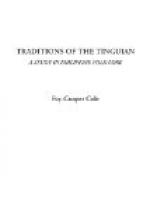When the people from the different towns arrived by the spring in Kabenbenlan they were surprised because all the stones of the spring were of gold. Not long after they went up to the town. Next day Awig and Aponigonay started to go. “Ala, Aponigonay, take rice so that we may cook it in Kabenbenlan, because Aponibolinayen and Dagdagalisit have no rice to cook. What will Dagdagalisit use for his balaua? He ties a banana bark clout on his body. I do not think he has rice, so we will take some for us to eat. You people who live in the same town we go to attend balaua. You take food with you for Aponibolinayen and Dagdagalisit make balaua.” Not long after they went, and when they arrived in the place where the spring is in Kabenbenlan they saw the beautiful spring whose stones were all gold. The gravel which they used to wash the pottery with was all agates which have no holes through them. “I do not think that Dagdagalisit has a spring like this, for his clout is only the dry bark of the banana, but it is best for us to go and see in the town.” They went, and when they had almost reached the town the golden house twinkled. “We must not walk by the golden house,” said Awig. “We must not walk by that golden house, you say, but that is where the people are dancing,” said Aponibolnay. As they walked they saw that the men and women who were making alawig [190] were the companions of Aponibolinayen. Awig said, “That is the man who used to put the clout of banana leaves on him.” As soon as Aponitolau [191] and Aponibolinayen finished dancing they went to take the hands of Awig and Aponibolay, and Aponitolau commanded the people who lived with them to bring golden seats. After that Aponitolau went to make Awig sit down. “You sit down, brother-in-law, and we will forget the things which have passed.” Then he made him sit down and soon Awig and Asigtanan danced. While they were dancing Aponitolau went to cut off Awig’s head. Not long after the women who never go outdoors [192] went to bring Awig to life. As soon as they made him alive again, Aponitolau gave the marriage price. It was nine times full, the balaua, and when Aponibolnay raised up her elbow half of it vanished, which was in the balaua. And Aponibolinayen used her power and the balaua was full again.




